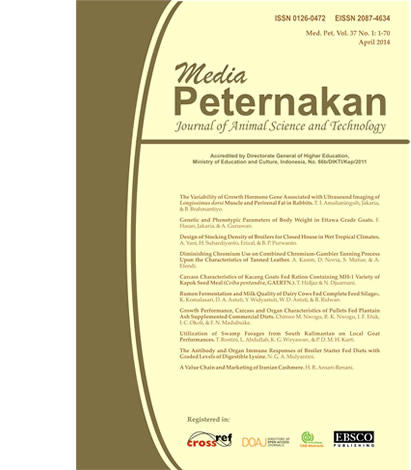The Variability of Growth Hormone Gene Associated with Ultrasound Imaging of Longissimus dorsi Muscle and Perirenal Fat in Rabbits
DOI:
https://doi.org/10.5398/medpet.2014.37.1.1Abstract
Identification of genes in rabbits correlated to economic traits were intended to improve and develop their genetic quality. The objective of this research was to analyze the variability of growth hormone gene (GH) in three rabbit breeds, i.e. Rex, Satin, and Reza (Rex and Satin crosses) then was associated with ultrasound imaging of Longissimus dorsi muscle and perirenal fat thickness. Identification of the variability of growth hormone gene was analyzed using PCR RFLP technique from blood samples of 33 mature male rabbits in Indonesian Research Institute for Animal Production (IRIAP). Thickness of Longissimus dorsi muscle and perirenal fat were imaged and measured by using ultrasound unit at 2nd to 3rd lumbar vertebrae in the left body side. PCR product of GH gene fragment (231 base pair /bp) was digested with restriction enzyme Bsh1236I. PCR-RFLP patterns were allele T resulted in an undigested fragment of 231 bp; allele C resulted in fragment of 169 bp and 62 bp. The result showed that Bsh1236I GH gene had three genotypes, i.e. CC, TT, and CT. There were signifficant association of Longissimus dorsi muscle thickness between rabbit breed (P<0.05). There was no significant association between GH Bsh1236I gene polymorphism and imaging ultrasound of Longissimus dorsi muscle and perirenal fat thickness. The association of characteristic genotype of GH|Bsh1236Igene with measurement phenotype was not significant, however it had potency as marker assisted selection (MAS).
Key words: growth hormone gene, Longissimus dorsi, perirenal fat, rabbit, ultrasound
Downloads
Download data is not yet available.
Downloads
Published
2014-07-10
Issue
Section
Articles



